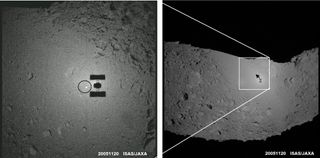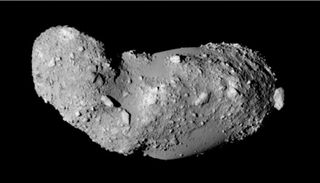Quest to Reveal Asteroid's Mysteries Before Japanese Spacecraft's Visit

A Japanese spacecraft is on its way to some daring work at an asteroid. Hayabusa 2 is expected to reach Asteroid Ryugu in June or July 2018 and will drop several tiny landers on to its surface. The spacecraft itself will scoop up a sample of asteroid material for return back to Earth, just as its predecessor Hayabusa did at asteroid Itokawa a decade ago.
It's clear that a lot of engineering and precision is needed to achieve these maneuvers, far from home and in a zone that doesn't easily give second chances. So as Hayabusa 2 moves towards its target, astronomers on Earth are looking at Ryugu as much as they can to learn about its properties.
"Before you can send an interplanetary mission to a small body, it is important to know its orbit with the best possible accuracy, but you also have to know the object's properties," said Thomas Mueller, co-investigator for Hayabusa's thermal infrared imager instrument, in an email to Seeker. He is also leading the efforts to do a characterization of Ryugu before Hayabusa 2's arrival.
RELATED: Asteroid-Bound Spacecraft Snaps Stunning Earth Photos
The latest research is based on analyzing results from the European Herschel Space Observatory (in April 2012) and the NASA Spitzer Space Telescope (between January and May 2013). The astronomers attempted to map the rotation of the object using its light curve (the change in light as seen from Earth), which in turn led to estimating its spin and surface composition. A paper based on the research was recently published on the prepublishing site arXiv, and has been accepted in the journal Astronomy & Astrophysics.

Mueller, who works with the Max Planck Institute for Extraterrestrial Physics in Garching, Germany, has been interested in learning about small bodies in the solar system since his Ph.D. thesis, which he completed in 1997 — where he tried to apply infrared measurements of well-known targets to objects that were less well known, but still scientifically interesting. He's been working to characterize Ryugu (in collaboration with the Japan Aerospace and Exploration Agency, or JAXA) since 2008.
"Mission targets like Itokawa (Hayabusa mission in 2005) or Ryugu (Hayabusa-2 mission) always attracted my attention for many reasons," Mueller added, providing a list: "(1) The possibility to compare my model predictions with 'ground-truth' at some point; (2) the relation to space projects (I worked in the European Space Agency for several years); (3) the connection between near-Earth objects and Earth (NEAs as a risk for Earth, but also as the origin of life, water and heavy element supply); (4) to find out more about the building blocks of the planets."
Get the Space.com Newsletter
Breaking space news, the latest updates on rocket launches, skywatching events and more!
RELATED: Japanese Asteroid Probe to Fish for Ingredients of Life
Specifically for Ryugu, Mueller says the latest research will help engineers adjust their instrument settings, do risk assessments and develop plans for what the spacecraft will do when it gets there. Some of the things they have covered include Ryugu's estimated size, brightness (known as albedo), rotation period and spin axis, thermal properties and where grains of different sizes are distributed.
But there are challenges with observing a small object from so far away. The new paper notes that because Ryugu is nearly spherical, it made it hard to get a light curve. So the astronomers combined radiometric and lightcurve inversion techniques to come up with an estimation of Ryugu's physical and thermal properties.

"In all our observations, we see Ryugu as a perfect point source (we cannot resolve the target from Earth distance)," Mueller added. "However, we are able to derive not only the size, shape, spin properties, but also things like the (most-likely) surface material (carbonaceous, complex organics?) or predominant grain sizes on the surface (1-10 mm)."
He added that both Itokawa and Ryugu are "fantastic opportunities" to see how well models hold up against ground truth. The astronomers are lucky to have this opportunity, as only a fraction of small bodies are visited by spacecraft, he said.
"Other experts in the field of small-body characterization/modelling will very likely pick up our published observations to make their own predictions," he added. "It is very exciting for us to see who gets closest to the truth."
Originally published on Seeker.
Join our Space Forums to keep talking space on the latest missions, night sky and more! And if you have a news tip, correction or comment, let us know at: community@space.com.

Elizabeth Howell (she/her), Ph.D., is a staff writer in the spaceflight channel since 2022 covering diversity, education and gaming as well. She was contributing writer for Space.com for 10 years before joining full-time. Elizabeth's reporting includes multiple exclusives with the White House and Office of the Vice-President of the United States, an exclusive conversation with aspiring space tourist (and NSYNC bassist) Lance Bass, speaking several times with the International Space Station, witnessing five human spaceflight launches on two continents, flying parabolic, working inside a spacesuit, and participating in a simulated Mars mission. Her latest book, "Why Am I Taller?", is co-written with astronaut Dave Williams. Elizabeth holds a Ph.D. and M.Sc. in Space Studies from the University of North Dakota, a Bachelor of Journalism from Canada's Carleton University and a Bachelor of History from Canada's Athabasca University. Elizabeth is also a post-secondary instructor in communications and science at several institutions since 2015; her experience includes developing and teaching an astronomy course at Canada's Algonquin College (with Indigenous content as well) to more than 1,000 students since 2020. Elizabeth first got interested in space after watching the movie Apollo 13 in 1996, and still wants to be an astronaut someday. Mastodon: https://qoto.org/@howellspace
